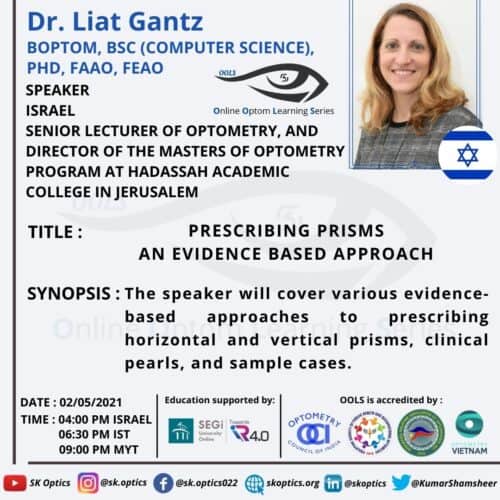
Dr. Liat Gantz, an optometrist, and an optometry educator and researcher, begins by explaining the key points from an evidence-based practice paper for prescribing prisms. We learn about prescribing prisms using the following pointer
- Verifying no prism adaptation (Vergence Adaptation)
The normal eye adapts when prisms are used the front of the eye. We learn how we measure dissociated phoria and how the eye will adapt to prisms(vergence adaptation). We are warned not to correct such phoria as the eye would adapt to the prisms. Next, we learn what happens when the visual system does not adapt to prisms and how such patients can be prescribed prisms. We learn a step-by-step method of prescribing prisms in practice.
- Treat only in the presence of binocular vision anomalies
We learn in detail about the three categories of binocular vision vergence anomalies
- Distance and near phoria are nearly same
- Basic Exophoria – we learn why distance phoria is not the case where prisms should not be the first choice of treatment.
- Basic Esophoria – Dr. Gantz, also explains the treatment for near phoria which includes prisms, reading glasses and vision therapy
- Distance phoria is higher than the near phoria
- Divergence Insufficieny – we learn about the symptoms and treatment options with the best option being base out prisms
- Divergence Excess – Convergence exercises is probably the best treatment plan for these patients.
- Near phoria is higher than distance phoria
- Convergence Insufficiency – vision therapy is the most effective treatment for convergence insufficiency
- Convergence Excess – we learn that the best solution for convergence excess is reading glasses.
- Clinician Discretion – no set of definitive rules
Dr. Gantz explains that there is no right criteria on prescribing prisms.
- Varying Approaches (criteria)
We learn about the four different approaches for horizontal prisms which includes
- Sheard’s criteria
- Saladin’s criteria
- Percival criteria
- Associated Phoria (52:50)
We also briefly learn about the approaches to prescribing vertical prisms
- Treat only when indicated
We learn when and when not to prescribe prisms with a few rules.
Dr. Gantz ends the session with a sample binocular vision anomaly case and explains all the different prescribing criteria for this one case. The session ends with a question and answer session with the live audience.
References
Papers
Gray LS. The prescribing of prisms in clinical practice. Graefes Arch Clin Exp Ophthalmol. 2008 May;246(5):627-9.
https://pubmed.ncbi.nlm.nih.gov/18379815/
Miranda A, Miah SJ. Design and Evaluation of a Contextual Model for Information Retrieval From Web-Scale Discovery Services to Improve Evidence-Based Practice by Health Care Practitioners: Mixed Methods Study. J Med Internet Res. 2019 Aug 21;21(8):e12621.
https://pubmed.ncbi.nlm.nih.gov/31436167/
Franklin DW, Wolpert DM. Computational mechanisms of sensorimotor control. Neuron. 2011 Nov 3;72(3):425-42.
https://pubmed.ncbi.nlm.nih.gov/22078503/
Shadmehr R, Smith MA, Krakauer JW. Error correction, sensory prediction, and adaptation in motor control. Annu Rev Neurosci. 2010;33:89-108.
https://pubmed.ncbi.nlm.nih.gov/20367317/
Helmoltz HV,.Handbuch der physiologischen Optik (Vol. 9): Voss
Petitet P, O’Reilly JX, O’Shea J. Towards a neuro-computational account of prism adaptation. Neuropsychologia. 2018 Jul 1;115:188-203.
https://pubmed.ncbi.nlm.nih.gov/29248498/
Lee SK, Zabrowski C, McClelland CM, Lee MS. Treatment of Horizontal Binocular Diplopia With Prismatic Contact Lenses. J Neuroophthalmol. 2021 Mar 1;41(1):e81-e82.
https://pubmed.ncbi.nlm.nih.gov/32235229/
Book:
Scheiman, M., & Wick, B. (2008). Clinical management of binocular vision: heterophoric, accommodative, and eye movement disorders. Lippincott Williams & Wilkins.
More Relatable Blogs:
- https://visionscienceacademy.org/eye-tracking-technology-in-ophthalmic-practice-a-prevue/
- https://visionscienceacademy.org/predictive-factors-for-the-binocular-vision-dysfunctions-among-children/
- https://visionscienceacademy.org/sports-vision-how-to-assess-and-train-for-eagles-eyesight/
- https://visionscienceacademy.org/saccadic-eye-movements-doorway-to-a-persons-wit/
